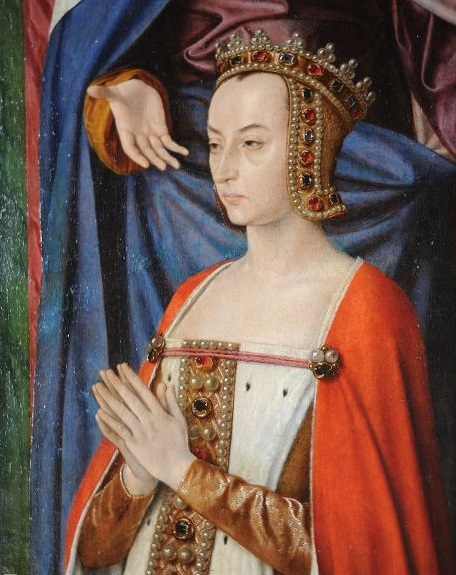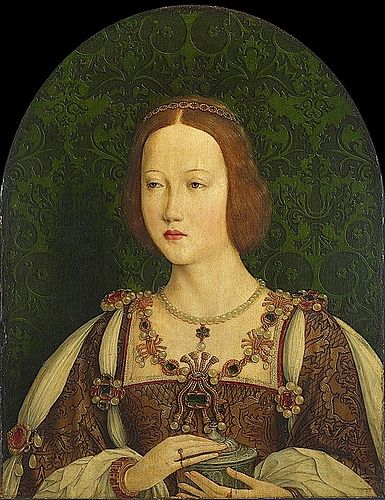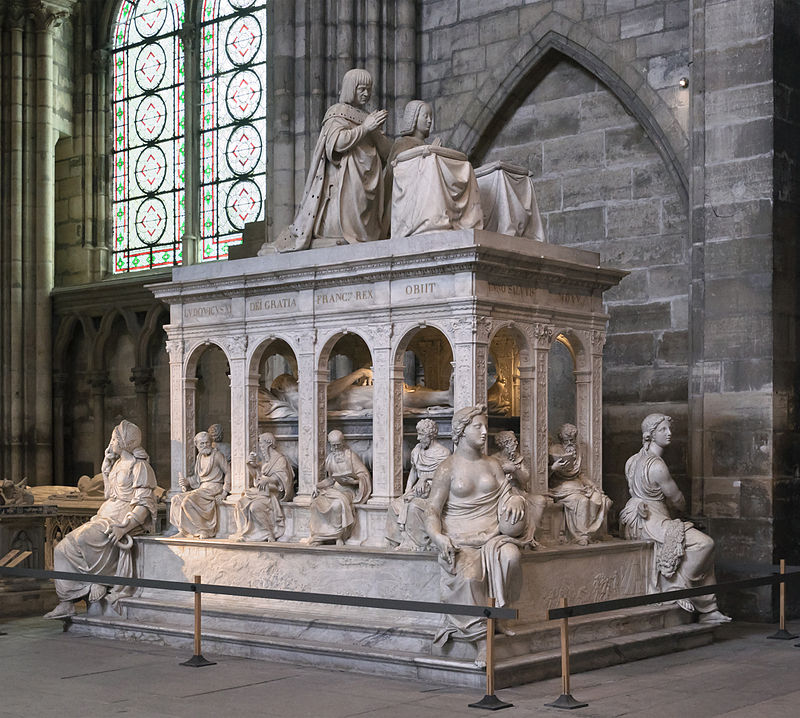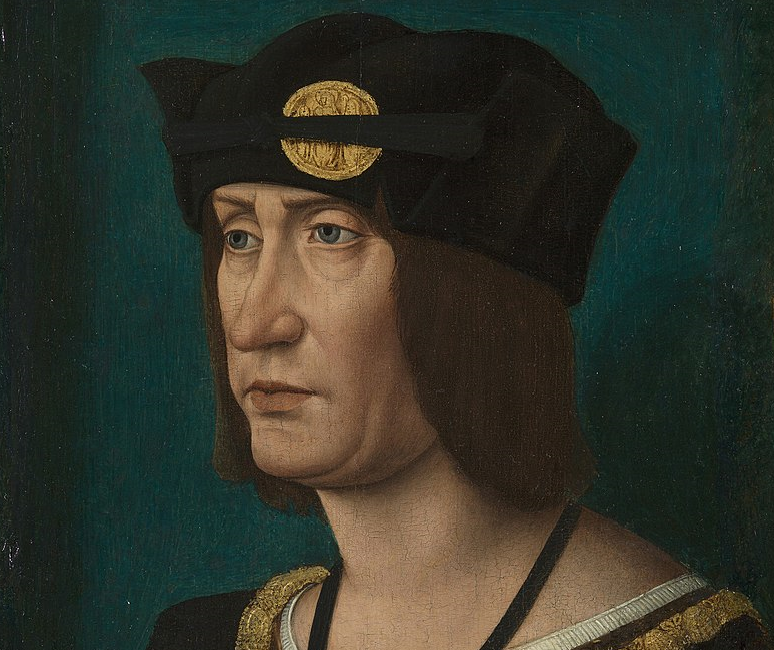King Louis XII of France was born on the 27th of June 1462 at Château de Blois. The son of Duke Charles d’Orléans, and Mary of Cleves, Louis XII succeeded his father only at the age of 3. King Louis XI appointed the chief councilors and servitors of the young duke to control and watch over his little cousin’s lands. Later in life, two man sharing the same name had many frictions.

Louis ascended the French throne unexpectedly, following his reigning cousin’s lethal accident. King Charles VIII had stumbled and hit his head on the lintel of a doorway through which he had been passing on his way to watch a tennis match. At the time, Charles had resided at Château d’Amboise. The blow had been deadly for Charles, who had breathed his last soon afterwards without any surviving male issue. Thus, the crown passed to his nearest male relative because in France a woman could not rule due to the Salic law. Louis, a former Duke d’Orléans, was crowned king in Rheims Cathedral on the 27th of May 1498.
At the time, Louis was married to his distant Valois cousin – Princess Jeanne de France, second surviving daughter of King Louis XI. The couple had been forced to marry by the long departed monarch because Louis XI had hoped that his namesake cousin would fail to sire a child on his handicapped and sickly daughter. Young Louis had been furious, but he had obeyed, and his further bad treatment of Jeanne showed his attitude towards her. This plan would have extinguished the Orléans cadet branch of the House of Valois, but it was not meant to be, for Louis XI could not have predicted that his only surviving son, Charles, would die young and childless.

Upon his ascension as Louis XII, the new monarch proceeded to obtain an annulment of his unfortunate marriage to Jeanne, who had indeed failed to bear his children. Perhaps Jeanne was sterile, or Louis hadn’t consummated their marriage – we will never know. Planning to marry the late king’s widow, the still young Anne of Brittany, in order to annex the Duchy of Brittany to the French Crown, Louis appealed to the Vatican for the nullification of his first marriage on the grounds of him having been below the legal age of consent (14) to marry and on the grounds of the non-consummation of this union due to his wife’s physical deformities that he described in details. In the Middle Ages, marriages could be dissolved by the Pope because of consanguinity, which had long become the general excuse for this, but Louis chose a different path.
The poor sickly Jeanne, who was not a beauty at all, fought against the charge like a lioness at first. Her witnesses confirmed that Louis had bedded her on their wedding night. In response, Louis said that his inability to know his wife carnally was caused by witchcraft. Quite a low thing to do on his part, right? Jeanne could have won, but Pope Alexander VI declared their marriage null and void for political reasons. Jeanne graciously consented, merely stating that she would pray for her former husband’s soul. A month later, Louis married Anne of Brittany on the 8th of January 1499 in Nantes, thus sealing the unification of Brittany and France.
Jeanne had suffered gracefully during their marriage and endured his abhorrence towards her, but Louis did not appreciate her benevolence and kindness. Louis made Jeanne Duchess of Berry in compensation for the loss of the crown, and she relocated to Bourges, the duchy’s capital. Wishing to become a nun, she began to establish the new Order of the Annunciation of the Blessed Virgin Mary in honor of the Annunciation. She herself wrote the rules of life in the Order that was approved in 1502 by the Bishop of Rome. She also helped create the Apostolic Sisters of the Annunciation to teach the children of the poor.

Prior to his ascension, Louis had gained the reputation of a troublemaker and a womanizer. When he had not been king, he had spent most of his time hunting, which was his life-long passion. He had also made for himself many foes due to his strained relationship with the real powers during the early reign of Charles VIII – the monarch’s elder sister, Anne de France also known as Anne de Beaujeu (she was Jeanne’s elder sister), and her husband, Pierre de Bourbon. Eventually, he had made peace with Anne and Pierre, and Louis had even been godfather of Charles VIII’s son, born in 1492 and named Charles Orlando. Yet, the boy had died of measles at the age of 3.
At first, nobles were wary of the new monarch, remembering Louis’ plotting against Anne de France. As the first prince of the blood, he had not been pragmatic and failed to outsmart the smart and conniving Anne de France. But Louis was not a boy anymore: he was still a relatively young man who obtained the throne at the age of 35, so he did nothing to anger and alienate the French nobility by settling old scores with them. Louis’ strategy was clever and careful: he did not exclude the most important nobles, but he ensured that they could not create independent alliances against him.
To alleviate the concerns and misgivings of the aristocrats, Louis XII is known to have said:
“It is not honorable for the King of France to avenge the quarrels of a Duke of Orleans.”
Like Charles VIII, Louis XII reorganized and reformed the royal administration, in particular the legal system. An intelligent and reasonable man, Louis reduced taxes, despite his plans to invade Italy in the near future, and substantially improved the government, just as his contemporary Henry VII acted in England. Reductions in taxes without reducing the income of the royal treasury were accomplished mostly through economies such as decreasing noble pensions and far stricter control of the fiscal system, especially expenditures of the royal court. This achievements later earned Louis the title ‘Father of the People’, in spite of the continuous Italian wars.
The Ordinance of Blois of 1499 regulated the French Church, judicial, and financial affairs, as well as the redaction and codification of many customary laws throughout the kingdom. This royal edict was aimed to eliminate corruption within the judicial system and to bring fairer and more uniform justice to everyone. The positions of magistrates could not be purchased: to become a magistrate, a person must be qualified for this role, be competent and trained in the law. These were not innovations, but Louis’ reforms were a careful improvement of past practices while he also added something new according to the needs of the state and the people.


The Italian projects were at the center of Louis’ policies and dreams. In 1499, he descended upon Italy like a blast of wind in search of conquest and glory. As his grandmother was Valentina Visconti, Louis believed that he had a legal claim to the Duchy of Milan, so his troops crossed the Milanese border, and in September 1499, after Duke Ludovico Sforza had escaped, the city surrendered to the French. An elated Louis became Duke of Milan. In October, Louis made a triumphal entrée into Milan, where he soon received the news of the birth of Claude de France – a girl, not a male heir who was desperately needed for the Valois line rather depleted of males.
After his success in Milan, Louis craved to conquer Naples, but he nevertheless realized that he had too many opponents. Thus, Louis allied with Ferdinand of Aragon: they signed the Treaty of Granada of 1500: they agreed to cooperate in the conquest and divide the country afterwards. The two monarchs were successful, and the Pope issued a bull naming both Louis and Ferdinand as his vassals in Naples. However, their relations soured considerably quite soon, and they started negotiations regarding their disagreements. Unable to resolve them civilly, the two rulers launched offensives against each other. Unfortunately for Louis, his troops were defeated at the Battle of Cerignola in April 1503 and then at Garigliano in December 1503, which compelled him to withdraw from Naples, leaving it to Spain.
Niccolò Machiavelli in his famous ‘The Prince’ wrote of Louis’ failure to hold on to Naples:
“If France could have taken Naples with her own power, she should have done so; if she could not, she should not have split the kingdom with the Spaniards. The division of Lombardy that she made with the Venetians was excusable, since it gave Louis a foothold in Italy; the division of Naples with Spain was an error, since there was no such necessity for it. Then Louis made the final mistake of depriving the Venetians of their power (who never would have let anyone else into Lombardy unless they were in control), he thus lost Lombardy.”

However, Louis’ Italian dreams were not over yet. He achieved his greatest success in the War of the League of Cambrai of 1508-1516, which was his final Italian campaign. During this war, there were many twists and turns of diplomacy and the reversals of alliances. Louis fought against the Venetians, who had become his enemy, although France had been allied with them before the invasion of Milan. Backed by Pope Julius II who was against the Republic of Venice, Louis moved rapidly into Venetian territory at the head of his army and confronted the Venetians at the Battle of Agnadello in April 1509, which resulted in their complete defeat. Louis quickly proceeded to occupy the lands of Venice, while the Pope issued an interdict against every Venetian person.
Trapped in a desperate situation, the Doge of Venice resolved to reconcile with the Vatican. The Pope’s conditions for reconciliation were harsh: Venice lost her traditional power to appoint clergy in her territory and jurisdiction over Papal subjects in Venice. As a result, the League of Cambrai collapsed. In October 1511, the Pope proclaimed a Holy League against France that included Spain, the Holy Roman Empire, and England, for young King Henry VIII dreamed of subjugating northern France or at least part of it. This eventually drove the French from Italy in 1512.
Yet, the shift in alliances re-launched the Italian wars just one year later. When Pope Julius threatened to form a new league against Venice, the Franco-Imperial alliance was resurrected. In March 1513, France and the Republic of Venice signed the treaty, according to which they would divide northern Italy between them. However, Pope Julius died in February, and Cardinal Giovanni de’ Medici, son of Lorenzo the Magnificent, was elected Pope Leo X. Nonetheless, in May 1513, the French, which were commanded by Louis de la Trémoille, not King Louis XII due to his deteriorating health, crossed the Alps and marched to Milan, but at the Battle of Novara in June 1513, the French army was crushed by the Swiss mostly due to their superior numbers.
An ailing Louis watched the Italian tragedy from France. He must have been completely devastated upon getting the tidbits about how his soldiers were fleeing through the Alps back home. More bad news came: King James IV of Scotland, who had invaded England from the north in accordance with his agreement with Louis, was vanquished and killed at the Battle of Flodden in September 1513. Moreover, Ferdinand of Aragon rapidly consolidated his hold over southern Navarre and moved to support English offensive in the province of Guyenne. Louis, who was already a widower in 1514 (Anne of Brittany died in January 1514) needed to conclude a truce with England.

During his 15-year marriage to Anne of Brittany, Louis’ second spouse was pregnant many times, but she produced only two daughters – Princesses Claude and Renée de France. Louis should have anticipated such an unfavorable outcome for him: Anne had birthed seven stillborn or shortlived children during her previous marriage to King Charles VIII. With Louis, Anne was more successful as her two daughters survived into adulthood, but their two sons were stillborn, and she also had as many as five miscarriages. As Cardinal Wolsey negotiated a peace treaty with France, one of its terms and conditions was Louis’ marriage to a young English princess.
In October 1514, Princess Mary Tudor married King Louis XII of France at the age of 18. His heir presumptive was his closest male relative – his young and flamboyant cousin, François d’Angoulême, who took his daughter, Claude, as his wife in 1514; Claude succeeded her mother as Duchess of Brittany, ensuring that the duchy would remain unified with France. Louis was not destined to enjoy his young wife for long: he suffered from a severe gout and died in about three months after the wedding at Hôtel des Tournelles in Paris. His successor was the art-loving King François I of France, who was also a descendant of Valentina Visconti and entertained many Italian dreams.
Of all the French monarchs in the late Middle Ages and the Renaissance, King Louis XII is probably the most difficult one to assess his reign largely due to the lack of reliable contemporary documentation. After his death, the 16th-century historians labeled Louis as ‘a model of the good king’. Yet, that is clearly an idealization! Sometimes, to fund his Italian campaigns, Louis collected more annual taxation from his subjects than Louis XI, often criticized for his taxation policies, had done. Yet, at the end of Louis’ reign, the deficit in the state treasury was approximately the same as it had been upon his ascension.

Undoubtedly, the early 16th century was quite a prosperous, vibrant era for France, whose population lived in peace and enjoyed relaxation in the tax policies. The country was gradually recovering from the previous disastrous centuries when the kingdom had been ravaged by the English during the long Hundred Years’ War. Louis’ ability to finance his expensive foreign campaigns while reducing taxes was mostly owing to the fortunate coincidence of circumstances.
All images are in the public domain.
Text © 2020 Olivia Longueville






Bonjour d’Amboise.Typo? Anne married Charles in Langeais. She married Louis in Nantes.Cordialement.
Hello Pamela! I will need to check it. Yes, Louis XII married Anne in Nantes – that is correct. Thank you – I made a small change. There are so many articles and writings that sometimes it is possible to forget something